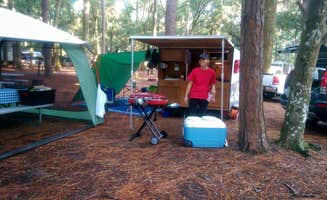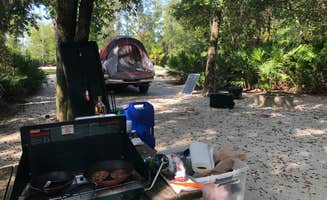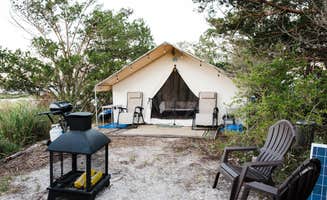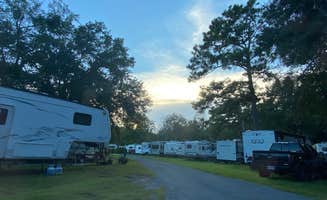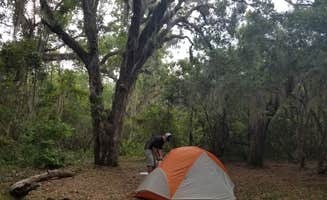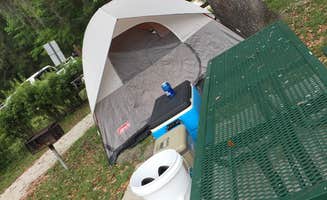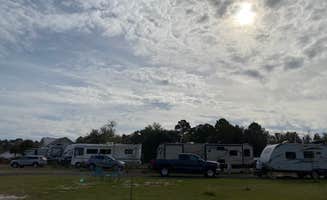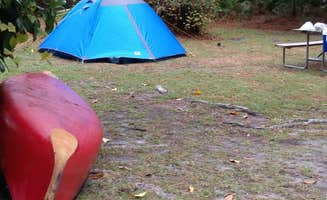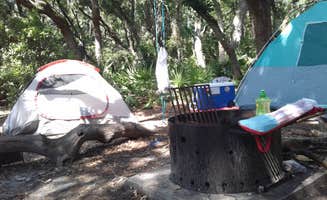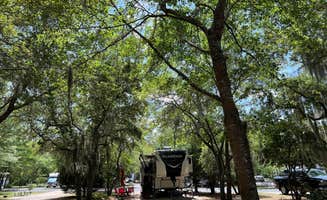Coastal Georgia camping spots near St. Simons Island, Georgia range from oceanfront sites with Atlantic views to wooded inland campgrounds along the area's tidal creeks. The region sits at an average elevation of just 10 feet above sea level, creating unique coastal ecology where freshwater meets saltwater in extensive marsh systems. Summer overnight temperatures rarely drop below 70°F even after sunset, requiring campers to prepare for warm sleeping conditions.
What to do
Beach exploration at Jekyll Island: Jekyll Island Campground provides convenient beach access within biking distance. "Driftwood Beach is walking distance and a must see," notes a camper, highlighting one of the area's most photographed natural attractions.
Kayaking tidal waterways: Crooked River State Park Campground offers exceptional paddling opportunities with ranger guidance. "The people in the bait shop were very helpful at helping us plan our route with the tide," shares one visitor who appreciated the expert local knowledge.
Historical site visits: Cumberland Island National Seashore offers rare access to preserved historic ruins. "The ruins of an old mansion look like a much older archeological site," explains one camper about the Dungeness Ruins, remnants of the Carnegie family estate that burned in 1959.
Wildlife watching: Blythe Island Regional Park features exceptional wildlife viewing opportunities. "Loaded with bunnies and squirrels who don't mind humans. Drove our dog crazy the first day!" reports one visitor about the abundant small mammals throughout the campground.
What campers like
Access to multiple islands: Jekyll Island Campground serves as an ideal base for regional exploration. "Nice access to Beach, quite campground," notes one reviewer who appreciated the convenient location for accessing multiple coastal destinations.
Clean facilities: Travelers consistently mention facility cleanliness at Crooked River State Park. "New family style bath house and an older bathhouse, both were very clean," writes one reviewer who appreciated the well-maintained amenities.
Shade coverage: Blythe Island Regional Park offers extensive natural canopy. "All sites heavily shaded. Clean and well maintained with full hook up," reports a camper who stayed at a lakefront site.
Privacy between sites: Despite proximity at many campgrounds, natural barriers create privacy. "The sites were very well shaded under a tree canopy with full hookups," notes a Jekyll Island Campground visitor describing how vegetation creates natural separation.
What you should know
Entrance fees beyond camping costs: Jekyll Island requires an entrance fee for all vehicles. "There is an extra fee/toll to get out to the island to be aware of. Well worth it!" mentions one visitor about the additional $10 vehicle charge.
Limited or no connectivity: Cumberland Island National Seashore offers a truly disconnected experience. "I had next to zero connectivity – which was great! But the real point here is to prepare not to be able to communicate with the outside world during your entire stay," advises a camper.
Ferry requirements: Access to Cumberland Island requires advance planning. "The only way most people can arrive to Cumberland Island is by ferry from St. Mary's," explains a visitor who warns that tickets should be purchased "WELL IN ADVANCE."
Wildlife protection measures: Food storage requirements exist at several campgrounds. "Keep all your food and scented items in the racoon proof cages or make sure your coolers/food boxes are locked! Raccoons will pry open just about everything!" warns a Cumberland Island camper.
Tips for camping with families
Water activities beyond beaches: Jacksonville North-St. Marys KOA offers multiple water features. "They have a lot of things for the kids to do such as swimming, water slide, playground, mini golf," reports a family who enjoyed the developed amenities.
Bike-friendly exploration: Jekyll Island's extensive trail network accommodates all ages. "You really need a car or bike to explore the island," advises one camper who appreciated the safe cycling infrastructure.
Educational programming: Several parks offer ranger-led programs. "The rangers were excellent during the nature education. We truly enjoyed touching and learning about local wildlife," shares a visitor to Crooked River State Park who participated with children.
Camping alternatives: Fort Clinch State Park provides options for families new to camping. "Beach and forest camping" are available, mentions a visitor, highlighting the variety of settings within a single park.
Tips from RVers
Site selection considerations: Coastal GA RV Resort provides privacy features between sites. "Sites aren't really big, but are separated by bushes, trees so provides some privacy," notes one RVer about the thoughtful layout.
Road conditions: Several campgrounds have challenging internal roads. "Roads are poor, rutted and full of holes," warns a visitor to Blythe Island Regional Park, suggesting careful navigation for larger rigs.
Weather preparation: Fort Clinch State Park campers should prepare for extreme humidity. "Heat index was over 100 so didn't do much hiking, but this was a really nice place to spend a few nights," shares an RVer who suggests bringing a battery-operated fan.
Facility access: Campground gate hours vary seasonally. "Check-in is 3 PM but the ranger station closes at 5 and gates lock shortly after," warns a Fort Clinch visitor, recommending calling ahead for access codes if arriving late.


